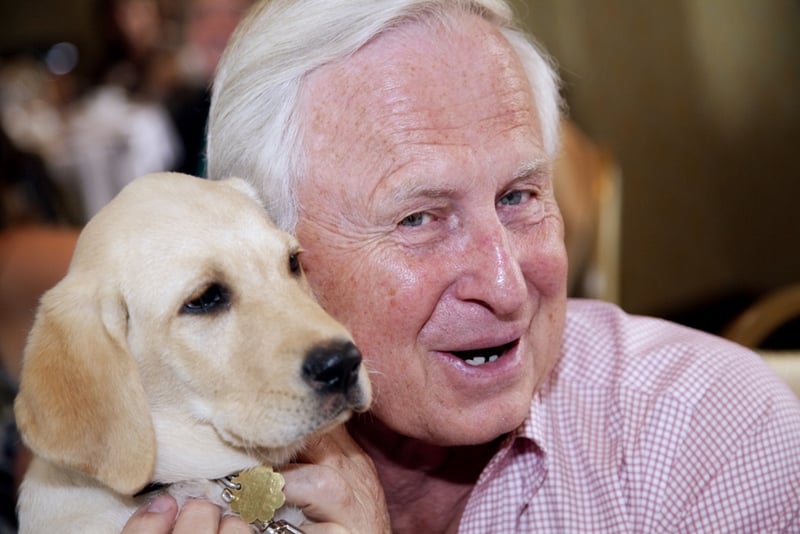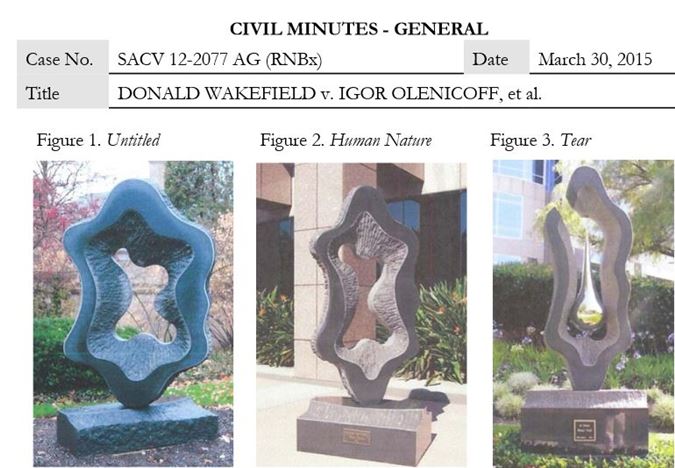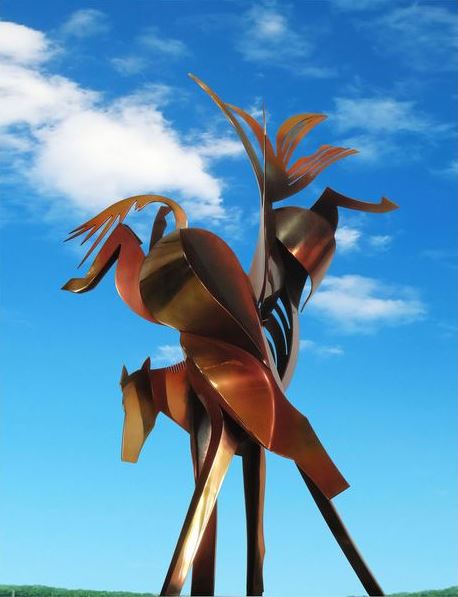Analysis
Billionaire Igor Olenicoff, Guilty of Making Knockoffs of Famous Artworks, Will Pay Zero
One artist saw several copies of his one-of-a-kind work at Olenicoff's properties.

One artist saw several copies of his one-of-a-kind work at Olenicoff's properties.

Eileen Kinsella

California real estate billionaire Igor Olenicoff—who Forbes says is worth $3.8 billion—has managed to hold on to another cool half-million of his cash. A judge ruled he is off the hook for damages in a copyright infringement case despite an earlier verdict against him (see Real Estate Tycoon Must Pay $450,000 in Chinese Sculpture Knockoff Theme).
Last year, a jury in a federal court sided with contemporary artist Donald Wakefield, ruling that Olenicoff and his company, Olen Properties, copied original elements from Wakefield’s copyrighted work and profited directly from the infringement. The jury awarded Wakefield damages of $450,000.
But on March 30, U.S. District Court Judge Andrew J. Guilford, of the Central District of California, found that “there was insufficient evidence to support the jury’s damages award,” even as he upheld the jury’s findings on liability and artist’s request for a permanent injunction.

Court documents show Donald Wakefield’s original sculpture Untitled (left) along with works commissioned by Igor Olenicoff from a Chinese sculptor. Human Condition (center) and A Tear Must Fall (right). Photo: Courtesy Pacer.gov
“We are very pleased with Judge Guilford’s ruling which properly applies the law pertaining to damages to this unusual set of circumstances,” William Buus, the attorney for Olenicoff, told artnet News. “It is unfortunate that Olen was sold artwork by a Chinese art broker that infringed upon Mr. Wakefield’s newly registered copyright. This ruling is the expected result when the copyright holder chooses to sue the purchaser of the art instead of the art dealers who are profiting from the infringement.”
The surprise reversal has echoes of a landmark copyright infringement suit filed against contemporary artist Richard Prince and his dealer Larry Gagosian in 2009, by French photographer Patrick Cariou, after Prince incorporated Cariou’s photos of Rastafarians into his 2008 paintings series “Canal Zone.”
A March 2011 ruling sided with Cariou, and even called for the destruction of the paintings. But that ruling was largely overturned on appeal. The two artists reached a confidential out-of-court settlement in March 2014. Interestingly, there are no images of “Canal Zone” paintings on Richard Prince’s official site. (See: Patrick Cariou Drops Lawsuit Against Richard Prince and When Is Artist on Artist Theft Okay? Jamian Juliano-Villani and Scott Teplin Duke It Out).
Wakefield creates large, one-of-a-kind stone and metal sculptures. According to court documents, Wakefield and a friend created a large granite sculpture, Untitled, in 1992. The sculpture was given to the friend’s son in Chicago, where it remains today, and the artist has not seen it since.
In 2008, Wakefield saw what he believed was his 1992 work at Olen Properties in Newport Beach, California. But after he discovered six others at various Olen Properties, in 2010, he realized it was a copy. The copies of Untitled, there are three in total, were called Human Nature’s Many Faces (Human Nature for short), for Olenicoff’s purposes. Three others were derivative sculptures based on Untitled and were known as A Tear Must Fall.
Wakefield sued Olenicoff for copyright infringement and other infringement related issues. At the trial Olenicoff testified that he first saw Human Nature in a sculpture garden in Beijing and purchased four copies from an artist there.
Wakefield argued that Olenicoff commissioned the sculpture from an artist in China only after seeing pictures of Untitled. He testified that he had emailed property developers including Olen Properties and that Olen used a picture from his website in a submission to the city of Brea, indicating that Olenicoff had visited his website and had access to images. He also argued the similarity between Untitled and the allegedly infringing works.
Last year, before jury deliberations began, Olenicoff filed a motion for judgement as a matter of law (JMOL). He argued that Wakefields’ claims are barred by the statute of limitations and and that there was insufficient evidence at trial to support claims for direct infringement. He also claimed there was insufficient evidence to justify the jury’s $450,000 damages award.
According to Judge Guildford’s decision, the court “denies in part and grants in part the JMOL. The statute of limitations does not bar Plaintiff’s claims and there was sufficient evidence to support the jury’s findings on liability, but there was insufficient evidence to support the jury’s damages award.”
The plaintiff “bears the burden of showing a causal link between the infringement and the monetary remedy sought. . .Mere speculation does not suffice,” to establish this link. The ruling said that a common measure of damages is “profits lost due to infringement…but Plaintiff doesn’t argue that he lost any profits…he testified that he never had nor never would produce copies of Untitled because he only creates original works of art.”
“We were happy that the District Court found infringement and ordered the infringing copies destroyed,” Gene Brockland, who with Michael Kuznetsky, is representing Wakefield, told artnet News via email. “We are considering the possibility of an appeal of the recent decision insofar as it found there was insufficient evidence to support the damage award. We believed there was sufficient evidence to support the award.”
More copycat sculptures?
Olenicoff seems to be no stranger to legal battles over copyright, not to mention some other, more serious financial matters. According to Forbes, in 2007, he pleaded guilty to tax felony charges for tucking away more than $350 million in Europe. He paid $52 million in back taxes and was sentenced to two years of probation and 120 hours of community service. He then turned around and sued UBS, who he claimed had mismanaged his investments and duped him into evading taxes. The same judge who made the latest ruling on the Wakefield case, Guildford, dismissed the UBS case in 2012.
According to Forbes, Olenicoff was born near Moscow in 1942. His Tsarist-connected family fled Russia for Iran. When he was 15, Olenicoff arrived in New York with his parents and his brother, with nothing but $800 and four suitcases. They were robbed.
In an earlier 2006 piece, Forbes called Olenicoff “The Billionaire With Empty Pockets,” detailing how he told the IRS he didn’t own Olen Properties. Confronted about this by Forbes, he told the magazine that since 1980, Olen had been owned by an offshore company—incorporated in the Cayman Islands, the Bahamas and then Denmark—in which he had no ownership.
In another copyright infringement case, a federal jury found Olenicoff liable and said he owed $640,000 in damages for making two illegal copies of abstract metal works by sculptor John Raimondi and displaying them at Olen buildings in California.

A sculpture by John Raimondi, Broncos (2014).
Artist Collection, Palm Beach Gardens, Florida. Photo: Courtesy jrsculptor.com.
Shortly before the start of the 2014 trial, according to Forbes, Olenicoff and Olen admitted that the copies infringed on Raimondi’s copyright, a claim they had denied for nearly two years. But Olenicoff’s lawyers continued to argue that Raimondi couldn’t prove any actual damages.
“The District Court has yet to rule on our request that the infringing copies be destroyed and Defendants motion for Judgment as a Matter of Law,” said Brockland, who is also representing Raimondi.
“Our position is the same in the Raimondi case,” said Buus about the Raimondi case. “We believe the plaintiff’s presentation of evidence at trial in that case suffered from the same fatal failure to prove damages as against the purchaser of the art. “